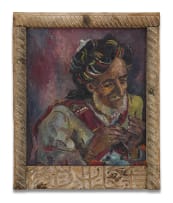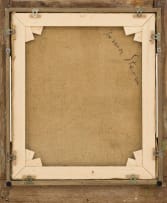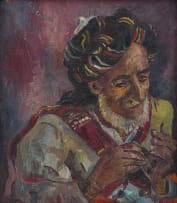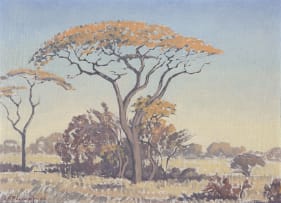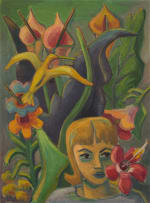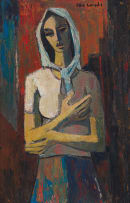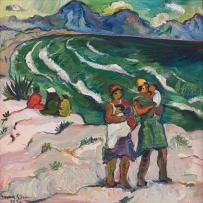Praying Arab
Irma Stern
Incl. Buyer's Premium & VAT
About this Item
signed and dated 1945; signed on the reverse
Notes
Irma Stern's celebrated portraits from her two working journeys to the East African island of Zanzibar are a tour de force of focussed energy and descriptive detail. Collectors rightly prize works from this triumphant period. Stern's vibrant palette, a potent signifier throughout her output, is in these canonical works complemented by her confident brushwork and mature restraint. The artist's earlier tendency to exaggerate and mythologise her various African subjects had abated. Praying Arab is a particularly fine example of the stylistic attributes characteristic of her golden period (roughly 1933-48).
Joseph Sachs and Elizabeth Moore, contemporary writers who had first-hand contact with Stern in the 1940s, both emphasize the 'realistic presentation' of subjects in her mature work.1 Stern's renovation of her style was hardwon and the outcome of endless refinement in the studio throughout the 1930s. By the time Stern made her first trip to Zanzibar in 1939 it had become a rote aspect of her painting practice.
In Stern's telling, her first working visit to Zanzibar was prompted by the sudden memory of an Arab cook who had been employed by her family in the artist's youth.2 Stern shortly booked passage to Zanzibar on a boat. This is an incomplete account. The rise of fascism in Europe and looming threat of war, coupled with Stern's growing disillusionment with the influence of modernity on her southern African subjects of the 1920s and earlier 1930s, arguably played a greater role in redirecting her travel itinerary.
Stern was familiar with Zanzibar from her many shipboard journeys to Europe. Its dominant Muslim culture, introduced by Omani settlers, would also have been broadly familiar to the artist. Stern, a non-observant Jew, had a strong interest in religions of the world. She collected ritual objects. Her art frequently depicted scenes of religious faith and ceremony. Starting in the 1920s, she began a long-term project depicting Cape Muslims. An ethnically diverse group of peoples linked by a common Muslim faith, Cape Muslims - or Malays - figured strongly as a distinctive category in Stern's output. Stern portrayed imams, minstrels, young brides and mature women.
In 1938 Stern broadened her enquiry into Islam in Africa by sojourning in Dakar, a majority Muslim city in West Africa, for four weeks. Her paintings of chiefly market folk were enthusiastically received in Cape Town. Painter Melvin Simmers praised the 'new sense of subtlety and luminosity' in Stern's Dakar works.3 Stern's Zanzibar works from a year later raised the bar. In 1942, literary scholar Joseph Sachs published Irma Stern and the Spirit of Africa, the artist's first and only South African monograph published during her lifetime. Issued three years before the making of Praying Arab, the book is notable for positioning Stern's Zanzibar works as exceptional in merit - 'the high water mark of her art,' writes Sachs.4 This opinion endures.
Sachs is revealing about Stern's methods as a painter in Zanzibar compelled to render fact; for example, a Muslim man at prayer: 'It is almost impossible to get any Arabs to sit for her: their religion precludes them having any images or likenesses in existence. But thanks to influence, persuasion and subterfuge she contrived to paint both the aristocratic and the plebeian Arabs of both sexes.'5 One trick of the trade saw Stern hire models in the market to pose for her. If Stern encountered difficulties explaining her needs in the studio, the artist told Moore, she would call a telephone exchange operator to translate her requests.6
Stern very likely employed this improvisational method to compose some (not all) of her portraits during her second visit to Zanzibar in 1945. Her use of models should not detract from a central ambition. 'The Zanzibarians are not types - they are all people,' Stern admonished a reporter.7 This insight abounds in her artist's book, Zanzibar (1948), a richly detailed and impressionistic account of her time on the island. Praying Arab's importance is clear from Stern's prominent positioning of it on page 11, after Arab Priest, owned by the Qatar Museums Authority, and Rich Old Arab, held by the Irma Stern Trust Collection.
Stern spent nearly four months in Stonetown. An industrious painter, she completed a number of drawings and paintings. Morris Cohen, a pioneering psychiatrist and art collector who in 1938 published a 44-page book on sculptor Anton Van Wouw, details how the artist paid a local Arab carpenter to frame her new works with wood from the island's ornately carved doorframes produced by Swahili artisans for Zanzibar's Arab elite.8 It was illegal, adds Cohen, to export complete doors. Stern circumvented the embargo, in 1939 purchasing an extant door that she shipped to Cape Town and installed at the entrance to her home. Cohen, who is the subject of a 1941 portrait by Stern, acquired Praying Arab from the artist.
Stern was a transactional artist who maintained her own ledger of accounts. She nonetheless placed great store in public opinion. Despite being advertised as not for sale, Praying Arab was in 1946 exhibited at the Argus Gallery in Cape Town with other Zanzibar paintings. 'The oriental inspiration which she has found in Zanzibar is precisely suited to her temperament and in many of these canvases she has translated the scenes and atmosphere, the rich personalities of the island, into memorable pictures,' reported the Cape Argus.9 The current lot was singled out, with The Golden Shawl, owned by the South African National Gallery, as 'particularly brilliant' and 'magnificent'. The Cape Times too named Praying Arab as praiseworthy, due to the 'textural qualities of the draperies and flesh values'.10 Works on offer were priced up to 250 guineas.
Stern also exhibited her new Zanzibar work at Bothner's Gallery in Johannesburg. 'Stern's colour loaded brush is finely attuned to the chromatic lushness of Zanzibar,' stated the Rand Daily Mail. 'Her journey there proves as rewarding as a pilgrimage.'11 Fogarty's Bookshop in Port Elizabeth presented a reduced selection of Zanzibar portraits alongside other works. The invitation card included a quote by Joseph Sachs: 'Irma Stern's art is a natural exuberance that wells up from her being.'12
The robust trade in South African art has one well-known drawback: great works of art such as Praying Arab are briefly visible soon after their making, and then promptly disappear into private collections, surfacing only at intervals, perhaps for exhibition or at auction. Praying Arab illustrates this dilemma of visibility. Intermittently traded, rarely exhibited and imperfectly illustrated, in 2021 the majesty of this key work from Stern's 1945 Zanzibar visit was reclaimed when it went on exhibition at Norval Foundation in Cape Town.
Curated by artist Karel Nel, The Zanzibari Years focused on Stern's work made during her two stays in Zanzibar and the period surrounding. The exhibition was bookended by the works Malay Priest (1931) and Pomegranate Seller (1948), both from the Rupert Foundation Art Collection. Praying Arab was installed on a wall featuring 11 male portraits, which, in Nel's view, collectively possessed the same gravitas as her portraits of socially prominent South African Jews.13 It was shown in a grouping with The Golden Shawl and The Smoker. Of these three works, Praying Arab is chromatically the darkest in its tonal register: the elderly sitter wearing a burgundy waist sash and black turban is presented against a vinous toned background. The overall palette compliments the psychological mood of the scene: a man withdrawn into himself at prayer.
In a public walkabout, Nel dismissed contemporary criticism that Stern was a painter of ethnographic types, offering instead that her portraits are a description of a community and evidence direct engagement with her sitters, many of whom were her social equal. The relationship between painter and sitter doesn't have a 'click of camera' quality, added Nel. 'She's not interested in the photographic, but direct engagement with a sitter.'14 It was a point first raised by Joseph Sachs. 'The main feature of modern art is the reaction against photographic representation,' asserted Sachs, whose book was met with the gift of a painting from Stern. 'Slavish imitation does not yield what is essential or characteristic in an object: it rarely recaptures that which makes it aesthetically moving.'15 Praying Arab distils Stern's remarkable facility in the age of the camera to record what is essential and moving with paint.
1. Elizabeth Moore (1946) 'Her Zanzibar Interlude', The Monitor, 22 March. Page 19. Joseph Sachs (1942) Irma Stern and the Spirit of Africa, Pretoria: J.L. van Schaik, page 38.
2. H.T. Lawless (1946) 'Spotlight: In the Limelight' Cape Times, 15 March.
3. Melvin Simmers (1938) 'S.A.'s Most Vital Painter: The Art of Irma Stern', Cape Times, 28 March.
4. Sachs, page 61.
5. Sachs, page 61.
6. Moore, page 19.
7. - (1946) 'An Artist's Travels', The Star, 24 April, page 4.
8. Morris J. Cohen (1946) 'Irma Stern: Johannesburg Painter', The Studio, Vol. 131, March, page 86.
9. - (1946) 'Irma Stern's Pictures: Inspiration from Zanzibar', The Cape Argus, 1 March.
10. P.H.W. (1946) 'Irma Stern's Notable Exhibition: Recent Canvases from Zanzibar', Cape Times, 2 March.
11. P.L.B (1946) 'Fine Zanzibar Paintings by Irma Stern', Rand Daily Mail, 26 April, page 8.
12. Box 4, Irma Stern Collection, National Library of South Africa, Cape Town.
13. Karel Nel (2022) public walkabout of The Zanzibari Years, 10 January, Norval Foundation, Cape Town.
14. Nel (2021) public walkabout, 2 November, Norval Foundation, Cape Town.
15. Sachs, pages 18 and 20.
Provenance
Dr Morris Cohen.
Sotheby's, Johannesburg, 2 May 1984, lot 304.
Private Collection.
Exhibited
Argus Gallery, Cape Town, Irma Stern: Exhibition of Paintings from Zanzibar, 1946.
Bothner's Gallery, Johannesburg, Irma Stern: Exhibition of Paintings from Zanzibar, 1946.
Standard Bank Gallery, Johannesburg, Irma Stern: Expressions of a Journey, 2003, cat. no. 69 with the date 1943.
Norval Foundation, Cape Town, The Zanzibari Years: Irma Stern, 3 November 2021 to 28 March 2022.
Literature
Irma Stern (1948) Zanzibar, Pretoria: J. L. Van Schaik, illustrated in black and white on page 11.
Stephan Welz (1989) Art at Auction in South Africa, Johannesburg: AD Donker, illustrated in colour on page 161.
Marion Arnold (1995) Irma Stern: A Feast for the Eye, Vlaeberg: Fernwood Press, exhibition catalogue, illustrated in colour on page 118 with the date 1943.

